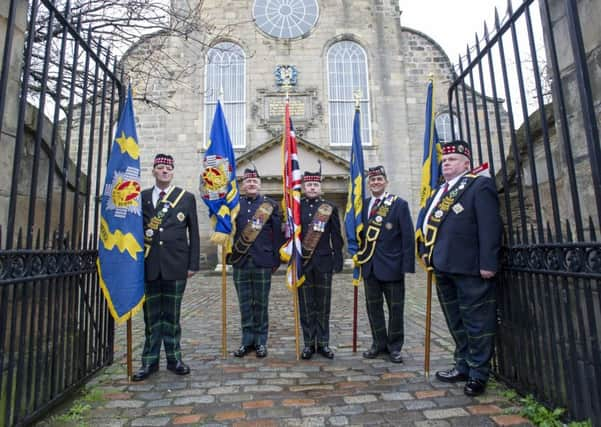Edinburgh’s Royal Scots Club a living memorial for the fallen 100 years on


The struggle to seize the state of mind of the city in the weeks following the First World War prompted a pioneering idea from an officer in the Royal Scots. Colonel Lord Henry, the younger son of the 6th Duke of Buccleuch, drew on his experience in the war – fighting shoulder to shoulder with men from all backgrounds – and came to the realisation, uncommon at the time, that it was not necessary to be of noble birth to be a gentleman.
And on March 11, 1919, exactly 100 years ago, instead of a monument built in stone to honour victims of war, Scotland’s only “living war memorial” – the Royal Scots Club – was founded as a tribute to the 11,162 Royal Scots soldiers who made the ultimate sacrifice. It was to be a place where rank, station or social standing was left at the door, and those men who had fought together in the trenches could gather regardless of the stiff social strata and strict military code. Colonel Lord Henry’s ambition to create the gentleman’s club for all ranks of the regiment in memory of its fallen, started him on a fundraising drive to make his vision a reality.
Advertisement
Hide AdAdvertisement
Hide AdIn February 1919, he called a meeting of distinguished Scots connected with the regiment and pitched his plan.
As a result the Royal Scots War Memorial Fund was formed, trustees were appointed and a public appeal was made which yielded £2,000 in the first week, growing subsequently to a staggering £17,000 – the approximate modern equivalent of about £5 million.
Premises were initially acquired as a temporary measure in the American army “leave” huts in St Andrew Square.
In 1921, 30 and 31 Abercromby Place were bought with number 29 being bought several years later.
Advertisement
Hide AdAdvertisement
Hide AdThe hall, and what was then the billiards room, now the function suites, were built to the rear of the building in 1929.
And today, Princess Anne will tour the Royal Scots Club to mark the launch of the Abercromby Place club’s centenary year.
As Patron of the Royal Scots Club and the Royal Scots Association, HRH The Princess Royal will be given a tour of the recently renovated interior, as well as meeting the trustees of the club. She will then launch a book, Not For Glory Nor Riches – One Hundred Years of the Royal Scots Club by Roddy Martine, for which she has contributed the foreword.
Major General Mark Strudwick CBE, chairman of the trustees of the Royal Scots Club, said the true generosity he believes is at the heart of the psyche of Edinburgh and Lothians was demonstrated in spades at a time of great hardship.
Advertisement
Hide AdAdvertisement
Hide Ad“There was over 100,000 Royal Scots in service, across 35 battalions – the scale of the carnage is unbelievable in present terms,” he added.
“I think over all the country there was disbelief with every family affected and from the Royal Scots not a family didn’t lose one or other of their brothers or sons.
“And instead of having a plinth, the creation of club meant everybody could come together – a rallying place for all was an immensely imaginative idea.
The First World War was a major change in the social situation and having a club where soldiers and officers could all meet was something was quite unique.
Advertisement
Hide AdAdvertisement
Hide Ad“We are delighted that our royal patron, has written the foreward to Roddy Martine’s book Not for Glory Nor Riches, 100 years of the Royal Scots Club.”
Eight Victoria Cross Stones, positioned at the front of the club’s entrance, will also be unveiled by Princess Anne in recognition of the brave soldiers who were awarded the medal – the highest and most prestigious British military honour. It is awarded for gallantry “in the presence of the enemy” to members of the British armed forces.
After the Second World War, a second Book of Remembrance was placed in the memorial cabinet at the club members’ entrance with the names of the 1,231 members of the regiment who lost their lives in that conflict.
Since then, the club has flourished and although it still proudly boasts its military connection, it is now open to all. It was one of the first all-male clubs to introduce membership for women, in 1981, and now 40 per cent of the members are female. Today, keeping the daily workings ticking over for nearly two decades is general manager Adrian Hayes.
Advertisement
Hide AdAdvertisement
Hide AdHe said a careful eye on changes and trends was vital for the club’s relevance.
And over the past few years significant refurbishment has created a tastefully decorated, comfortable place for members to eat, drink and relax regardless of their military background.
He added: “Civilians as well as those with military links really enjoy the fact the club can be somewhere to meet socially, for business reasons. The library has a number of desks suited to working from laptops in a pleasant, quiet environment. It is also a welcoming base for those travelling from overseas or other parts of Scotland.”
Steeped in its proud military history the club also has plentiful facilities for the modern era including 27 en-suite rooms, function suites, a restaurant, cocktail bar and lounge, library, private members’ lounge, with free tea and coffee.
For more information, visit www.royalscotsclub.com